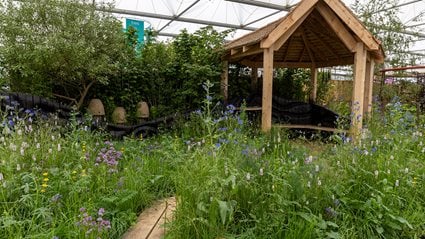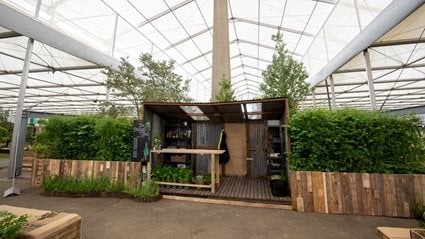This garden has been designed as a peaceful, sensory space to support stroke recovery. Sculptural Pinus sylvestris and Pinus mugo trees symbolise resilience in the face of stroke trauma; their anthropomorphic shapes offer a comforting alternative structure to the built environment of a hospital, their scent, a transportive effect.
Colour, fragrance and the sound of water provide soft way-finding for those with visual or mobility impairments, while a biodiverse matrix of native and non-native plants are chosen to meet the demands of different planting conditions in the garden.
The concept and material choices of the garden have all been inspired by the designer’s own experience of surviving a stroke and the stories of other people who have been affected by stroke.
At a glance:
Who is this garden for?
A garden to support recovery for all those affected by stroke.
Where is the garden set?
Yorkshire.
Who or what is the design inspiration?
Recuperation in the natural world.
Windswept pine trees frame views and a complementary planting scheme of pink, orange, yellow, purple and green help guide visitors on different routes through the garden. The interconnected pathways through a gentle contoured landscape acknowledge the always individual and often difficult road to recovery with its ups and downs.
Natural-built walls articulate spaces to rest and be with loved ones and allow for moments of privacy and calm with furniture designed by Olivia Gonsalves. A wildlife pond and stream provide an auditory dimension inviting gentle escapism from the more clinical aspects of stroke recovery and the rich tapestry of wildlife-friendly planting
Key sustainability points:
- Use of sustainable innovative materials; Hemp fibre corrugated panels are used as cladding for the boundaries of the garden and a prototype hemp composite paving is also incorporated into the design.
- Sustainable and low environmental impact design approach; incorporating biofiber carbon sequestration materials such as hemp.
- Celebrating environmentally friendly traditional crafts; lime rendering is used as a finish on the hempcrete blocks and the pond and stream is formed entirely from puddling clay
- Concrete and plastic free; by building the pond in a more traditional way, the garden can be single use plastic and rubber free while the use of lime, clay and hemp takes away the need for cement.
- Bio-diverse, resilient planting choices; combining native and non-native plants that can withstand a range of conditions and require a low level of intervention to maintain. Also featuring many plants for pollinators along with rocks, dead wood and plants that provide wildlife habitat, and seeds and fruit that provide valuable food sources.
Relocation:
The garden will be reconfigured as a permanent garden for the Stroke Unit at Chapel Allerton Hospital in Leeds. There is currently no suitable access to outside space, so the garden will provide a vital space for reconnection and rest for stroke survivors, their friends, families and carers. Prioritising the use of wildlife-friendly plants will not only increase the biodiversity of the existing municipal hospital landscape, but will also enhance patient’s direct access to nature and the positive impact on well-being that comes with it.
All Show Gardens



Balcony Gardens
The Discover More Garden sponsored by Viking
The Discover More Garden sponsored by Viking


Balcony Gardens
The Discover More Garden sponsored by Viking
The Discover More Garden sponsored by VikingGet involved
The Royal Horticultural Society is the UK’s leading gardening charity. We aim to enrich everyone’s life through plants, and make the UK a greener and more beautiful place.







